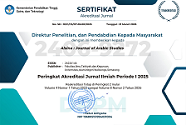Taḥlīl Muḥtawá al-Kitāb al-Madrasī lil-Lughah al-ʿArabīyah li-Ṣaff al-Sābiʿ li-Ḥasan Sayf Allāh bi-Madkhal Mutaʿaddid al-Wasa’iṭ
DOI:
https://doi.org/10.21580/alsina.7.2.28716Keywords:
Arabic Language Teaching, Multimodal Discourse Analysis, Systemic Functional Linguistics, Textbook Analysis, Visual-Verbal IntegrationAbstract
This study analyzes the Arabic language textbook for seventh grade authored by Hasan Saefulloh through a multimodal approach. This study is grounded in the recognition that textbooks continue to serve as one of the principal media for language instruction, yet their visual and textual integration is often less than optimal. The study employs a qualitative content analysis method using systemic functional linguistics (SFL) and multimodal discourse analysis by Kress and van Leeuwen. Data were drawn from selected pages of the textbook that contain prominent multimodal elements, including vocabulary lists, dialogues, illustrations, and page layouts. The findings reveal three major points. First, the book presents basic Arabic learning materials but the integration between texts, images, and layouts is still weak. Second, the multimodal elements often work in isolation without forming a cohesive meaning. Third, the lack of balance between visual and verbal representations may limit students’ comprehension and engagement. This research concludes that the textbook needs improvement in its design and organization, particularly in aligning verbal and visual modes to support effective Arabic learning. This study contributes to the enhancement of multimodal awareness in Arabic textbook design, offering insights for teachers, authors, and curriculum developers to produce more pedagogically integrated materials.
Downloads
References
Aulia, Vidya Isma, and Wulan Anggraeni. “Urgensi Pembelajaran Bahasa Arab Dalam Pendidikan Islam.” Uktub: Journal of Arabic Studies 3, no. 1 (2023): 22–40. https://doi.org/10.32678/uktub.v3i1.7854.
Babelyuk, Oksana, and Yuliya Zaza. “TENOR AS A MULTIMODAL REGISTER CHARACTERISTIC OF THE INSTAGRAM PROFILE (a Compared Analysis of Queen Rania’s Official Website and Instagram Profile in Arabic and English).” Alfred Nobel University Journal of Philology 2, no. 28 (2024): 310–11. https://doi.org/10.32342/3041-217X-2024-2-28-19.
Bateman, John A., and Chiao I. Tseng. “Multimodal Discourse Analysis as a Method for Revealing Narrative Strategies in News Videos.” Multimodal Communication 12, no. 3 (2023): 261–85. https://doi.org/10.1515/mc-2023-0029.
Beltrán-Planques, Vicent, and Mercedes Querol-Julián. “English Language Learners’ Spoken Interaction: What a Multimodal Perspective Reveals about Pragmatic Competence.” System 77 (2018): 80–90. https://doi.org/10.1016/j.system.2018.01.008.
Dontcheva-Navratilova, Olga. “‘We Want You to Be Informed’: Rhetorical and Pragmatic Strategies for Recontextualising Scientific Knowledge in Biology Video Abstracts.” Discourse, Context and Media 68, no. February (2025). https://doi.org/10.1016/j.dcm.2025.100938.
Fadhil, Wasan N. “Pragma-Multimodal Discourse Analysis of Environmental Slogans.” Journal of Language Teaching and Research 15, no. 3 (2024): 911–19. https://doi.org/10.17507/jltr.1503.24.
Freigang, Farina, Sören Klett, and Stefan Kopp. “Pragmatic Multimodality: Effects of Nonverbal Cues of Focus and Certainty in a Virtual Human.” Lecture Notes in Computer Science (Including Subseries Lecture Notes in Artificial Intelligence and Lecture Notes in Bioinformatics) 10498 LNAI (2017): 142–55. https://doi.org/10.1007/978-3-319-67401-8_16.
Gheni, Ali Abdulelah, and Fareed Hameed Al-Hindawi. “A Multimodal Social Semiotic Analysis of Typography and Layout in Alexander Master’s Novel Stuart: A Life Backwards’’.” Journal of Ecohumanism 3, no. 8 (2024): 13632–40. https://doi.org/10.62754/joe.v3i8.5879.
Halliday, M.A.K, and C.M.I.M Matthiessen. An Intriduction to Functional Grammar. London: Routledge, 2014.
Hanifah, Umu. “PENTINGNYA BUKU AJAR YANG BERKUALITASDALAM MENINGKATKAN EFEKTIVITASPEMBELAJARAN BAHASA ARAB.” At-Tajdid Jurnal Ilmu Tarbiyah, 2014.
Hasanah, Kartini Dwi, Dewi Anita, Silvina Wahab, Jazilatun Nawali, Helda Ivtari Savika, Mohammad Zubad, and Nurul Yaqin. “PERAN DAN RAGAM JENIS BAHAN AJAR ( CETAK DAN NON CETAK ) YANG RELEVAN DALAM PEMBELAJARAN BAHASA DAN SENI BUDAYA DI SDI Abstrak PENDAHULUAN Menurut Ahli Darman Bahwa Belajar Adalah Sebagai Usaha Sadar Yang Dilakukan Individu Untuk Merubah Diri Menjadi Lebi” 05, no. 01 (2024).
Hermawan, Budi. Analisis Wacana Multimodal Untuk Pemula. Bandung: UPI Press, 2021.
Hernawan, Asep Herry, Permasih, and Laksmi Dewi. “Pengembangan Bahan Ajar Tematik.” Direktorat UPI Bandung, 2012, 1489–97.
Ilmia, Siti Fahimatul, Rizqi Karimatul Khilmi, Cahya Edi Setyawan, and Maskanah Maskanah. “Critical Review of the 2023 Tenth Grade Arabic Textbook for Madrasah Aliyah under Kurikulum Merdeka.” Alsina : Journal of Arabic Studies 5, no. 2 (2023): 231–56. https://doi.org/10.21580/alsina.5.2.20893.
J. R.Firth. Papers in Linguistics 1934–1951. Oxford: Oxford University Press., 1957.
Jewitt, C. “Multimodality and Literacy in School Classrooms.,” 2008.
Kress, Gunther, and Theo van Leeuwen. Reading Images: The Grammar of Visual Design. Routledge, 2021.
Muftia, Ali, and Mudrofin Mudrofin. “Analisis Kesesuaian Kompetensi Dasar Dengan Bahan Ajar Bahasa Arab MTs Kelas IX Karya Yushi M. Mahmudah.” Alsina : Journal of Arabic Studies 3, no. 1 (2021): 81–102. https://doi.org/10.21580/alsina.3.1.10432.
Nur, Sajidah, Nurhadi Nurhadi, and Yuni Pratiwi. “Revolusi Buku Ajar Bermuatan Teks Multimodal Terintegrasi Media: Kurikulum Merdeka.” GHANCARAN: Jurnal Pendidikan Bahasa Dan Sastra Indonesia, no. November (2023): 377–96. https://doi.org/10.19105/ghancaran.vi.11769.
Ramadhanti, Rizka Laili, Azmi Al-Bahij, and Lailatul Mufidah. “Pengaruh Penggunaan Pembelajaran Kreatif Dan Inovatif Untuk Siswa Di Sekolah MI Muhammadiyah Butuh Kalikajar.” Seminar Nasional Dan Publikasi Ilmiah 2024 FIP UMJ, 2024, 1329–38.
S.Eggins. An Intriduction to System Functional Linguistics. London: Continuum, 2004.
Scholman, Merel, and Schuyler Laparle. “Can Gestures Speak Louder than Words? The Effect of Gestural Discourse Markers on Discourse Expectations.” Discourse Processes 62, no. 6–7 (2025): 457–78. https://doi.org/10.1080/0163853X.2025.2499414.
Smith, Christopher A. “Mapping Reflexivity in Situ: A Multimodal Exploration of Negotiated Textbook Discourses in Korean University EFL Classrooms.” Language Teaching Research 28, no. 4 (2021): 1368–90. https://doi.org/10.1177/13621688211024932.
Ulfah, Yeniati. “Kesulitan Belajar Bahasa Arab Bagi Mahasiswa Program Studi Pendidikan Agama Islam Universitas Islam Zainul Hasan Genggong.” TADRIS AL-ARABIYAT: Jurnal Kajian Ilmu Pendidikan Bahasa Arab 3, no. 1 (2023): 79–92. https://doi.org/10.30739/arabiyat.v3i1.1824.
Wang, Ruo Xi, and Kubanychbek Taabaldiev. “Exploring the Dynamics of Multimodal Discourse in Social Media News: Addressing Research Gaps in Interaction, Affordances, and Temporal Patterns.” Forum for Linguistic Studies 7, no. 5 (2025): 470–82. https://doi.org/10.30564/fls.v7i5.8542.
Wildgen, Wolfgang. “The Cognitive Roots of Multimodal Symbolic Forms with an Analysis of Multimodality in Movies.” Frontiers in Communication 9, no. May (2024): 1–9. https://doi.org/10.3389/fcomm.2024.1352252.
Published
How to Cite
Issue
Section
License

This work is licensed under a Creative Commons Attribution-NonCommercial-ShareAlike 4.0 International License.
Copyright
The copyright of the received article shall be assigned to the publisher of the journal. The intended copyright includes the right to publish the article in various forms (including reprints). The journal maintains the publishing rights to published articles. Authors are allowed to use their articles for any legal purposes deemed necessary without written permission from the journal, but with an acknowledgment to this journal of initial publication.
Licensing
In order for Alsina: Journal of Arabic Studies to publish and distribute research articles, the editors need publishing rights (transferred from author to publisher). This agreement relates to the transfer/publishing copyright license to Alsina: Journal of Arabic Studies but the authors still have significant rights to use and share their published articles.
Alsina: Journal of Arabic Studies supports the need for writers to share, disseminate and maximize the impact of their research and their rights on any database. As a journal article writer, you have the right to various uses of your articles, including that by the institution or company where you work. Copyright can be used without the need for special permission. Authors who publish articles in the Alsina: Journal of Arabic Studies have broad rights to use their work for teaching and scientific purposes without requesting permission, including:
- Use by the author for lectures, presentations, or conferences, with distribution of copies to participants;
- Distribution to colleagues for research use;
- Use in compilations of the author's subsequent work;
- inclusion in a thesis or dissertation;
- Reuse of sections or excerpts from articles in other works (with full acknowledgment of the final article);
- Preparation of derivative works (other than commercial purposes) (with full acknowledgment of the final article);
- Voluntary posting on open websites operated by authors’ or writers' agencies for scientific purposes
When submitting a manuscript, authors do so on the understanding that if accepted for publication, the copyright for publishing (publishing right) of the article shall be assigned/transferred to Alsina: Journal of Arabic Studies.
Authors whose articles are accepted for publication will receive confirmation via email and sent a Copyright Transfer Agreement.

 Accreditation
Accreditation 
 In Collaboration with
In Collaboration with 

 Visitors
Visitors  Article Template
Article Template





